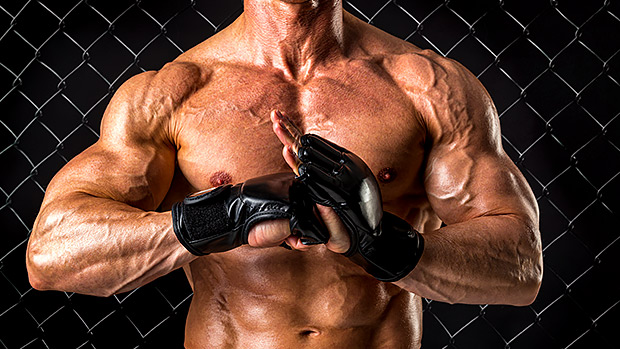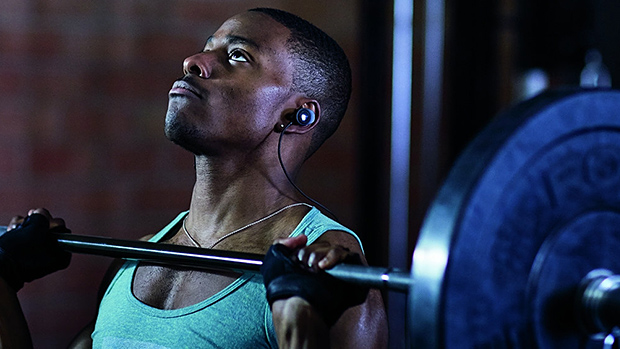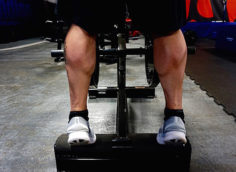You don't need to smash faces and choke out other guys to be a fighter. Whether you're knocking someone out or not, being as powerful as possible always pays off. So here are the top five upper-body exercises to build fight-strength that will carry over to the mats and life in general.
Why it's on the list
- Chains help improve your rate of force development (explosiveness) because you can accelerate through the whole movement.
- It's one of the best pressing lifts to develop starting strength.
- It's specific to the "guard position" (lying on your back with an opponent on top of you), and helps build confidence from a potentially compromised position.
Start by lying on the floor below a barbell placed in the power rack. Grip the bar tightly and lift it to a place directly above your sternum or slightly higher toward your shoulders. Lower the bar with control until your elbows touch the floor.
After a solid pause, press directly up to start position as forcefully as possible. No elbow-bouncing on the floor between reps.
Why it's on the list
- It develops explosive punching power.
- The position is specific to your fight stance. Even though it won't develop your fight technique, it'll certainly boost striking power.
- By training one side at a time, you'll increase body awareness, and even out potential imbalances in both strength and muscle development.
Set up a barbell in a landmine device or in a corner. Place one end of the band around the barbell and the other end under your mid-foot. Get in a staggered stance and press up as explosively as possible while leaning somewhat forward. Let your shoulder move freely and protract, similar to a punch.
Lower with control to the start position and instantly press back up again. After all reps are done, switch your stance and repeat.
Why it's on the list
- It builds horizontal pulling strength and upper-back muscles.
- Adding isometric holds in the top position builds "grinding strength" and the ability to better hold and control your opponent.
- Since the body position in the inverted row is similar to an inverted plank, it also helps to build static strength in the whole posterior chain.
Start below a barbell placed in a rack slightly higher than arm length from the floor. Place your heels on a weight bench. Grip on the bar with your regular bench press grip and elevate your body from the floor by fully activating your backside (calves, hams, glutes, lower, and upper back). Make sure the barbell is placed above your upper abdomen to allow for a horizontal elbow movement.
Elevate your chest, activate your lats, and get your shoulders packed before you start the movement. Pull yourself up until your chest reaches the barbell and keep tension for 2-3 seconds before you lower back to the start position.
Why it's on the list
- Standard pull-ups are one of the best exercises to build the lats, but the dead-stop chest-to-bar version is even better for increased performance.
- It's not about keeping muscle tension to build the lats; it's about forcefully contracting your pulling muscles from a dead-stop position. This develops your power, which has great carryover to better dealing with your opponent. Big muscles are great, but functional pulling strength is better.
- When you start from a fully extended and paused position, you'll develop what you actually need – real functional strength.
Start below a pull-up bar and take a slightly wider than shoulder-width grip.
Before you pull, make sure to hang freely with elbows and shoulders extended so you start from a dead-stop position. Press your chest up and activate the lats by slightly externally rotating the arms before you pull yourself up as explosively as possible.
Aim to go all the way up, touching the bar with your chest. This way you train the full range and avoid "cheating" by protracting the neck to finish the movement. Lower back to a dead stop and repeat.
Why it's on the list
- Too much arm training too early in your development is mostly a waste of time. But once you've laid your foundation you can get a lot out of it.
- Elbow flexion is important, not only for the sake of building biceps, but to increase fight performance. If you've ever had to grapple with an opponent, you surely appreciated the fact that you had "isolated strength" in your arms.
- Having strong biceps and being strong in elbow flexion helps to better handle and take control of the opponent and his joints. It'll also help you better withstand your opponents' intent to take control of YOUR joints.
Start from a standing position with a barbell and a band in your hands. Place the band below the midfoot of your feet and across the middle of your palms. From a fully-extended elbow position, explosively flex your elbows and hold the top position isometrically for 2-3 seconds. Lower back with control to a fully-extended position and repeat.





